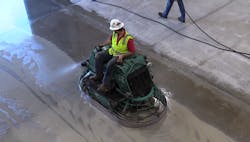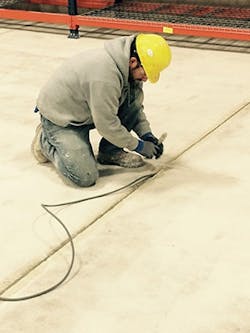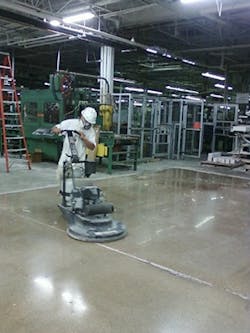A plant’s workforce, equipment, production machinery, and schedules are nearly always in motion. But facility managers often see what’s under their workers’ feet (e.g., flooring) as static, unchanging. The Occupational Safety and Health Administration (OSHA) requirements under the Code of Federal Regulations section 1910.22, which cover “Walking-Working Surfaces,” direct facility owners to, among other things, keep surfaces under foot clean and orderly or risk fines up to hundreds of thousands of dollars.
Temperature, humidity, thermal shock, equipment vibration, foot and vehicular traffic, spills, cleaning agents, and more make a plant’s floor a dynamic landscape. Some facility owners take a check-the-box approach to flooring; they simply want to pass the next inspection or fix an immediate problem. Patching problems can save money up front. But a short-term approach to industrial painting, coating, and flooring eventually spells injuries, work stoppages, or even cancelled contracts due to product contamination.
Savvy facility managers analyze situations, plan for improved outcomes, and spend money wisely. Flooring projects done well are no different. Below are some best practices by facility and maintenance managers who have strategically tackled flooring projects.
Find an impartial observer with expertise
Independent consultants and association can help select a flooring specification. The National Floor Safety Institute (NFSI) can recommend an NFSI WACH graduate who will assess the state of your facility’s floor, identify problems, and make recommendations. The National Safety Council offers assessments and consulting services that employers can tap into. And the International Concrete Repair Institute certifies people as concrete slab moisture testing technicians. Plant maintenance managers generally don’t know flooring specifications; and many vendors suggest the one they know best or are certified to use.
Look for credibility
Narrow a vendor search to those with case studies from your industry. For example, applying a flooring system to a logistics company’s warehouse requires different techniques than replacing the floor at a power generation plant or a food or agricultural facility. Food and beverage, for instance, requires understanding the Food Safety Modernization Act (FSMA) and preparing and cleaning surfaces and equipment in a way that ensures the finished floor is audit-ready. Ask if the vendor has NACE Level 3 inspectors on staff who know about floor coatings requirements.
Find vendors with a passion for their craft and familiarity with your processes. They’re more likely to run a project on time and on budget. A vendor should have experience (and certifications) applying a range of industrial flooring types (e.g., epoxy with an anti-microbial coating, vinyl, polyurethane or urethane) to specific flooring surfaces. For instance, understanding the condition and chemistry of concrete affects how well a coating adheres to the applied surface. A certification means more than understanding how to apply coatings and flooring safely and successfully; credentials speak to the business’ level of professionalism.
Make the most of references
Review a vendor’s case studies and speak with references. Ask references if they received everything they expected. Determine if the vendor self-performed the work or used subcontractors. Ask references about the vendor’s pre-project planning process. Find out if planning meetings included the vendor’s project manager, safety manager, and salesperson. These are the people who sell a facility manager the work, make sure the work gets performed safely and see it through to completion – it’s critical everyone is aligned.
Insist on a detailed plan and timeline before work begins
Require the vendor to present a plan laying out a day-by-day account of the project elements, timeline and contact information for the project leader. This ensures a crew arrives on day one and dives into the work.
The flooring project plan should answer questions like:
- How long will the project interrupt operations?
- What’s required to prepare the floor and remove the existing coating?
- How will the project manager ensure the new flooring properly adheres to the work surface?
- Does the coating have an offensive odor?
- Will adjacent areas need to be protected from dust created during the preparation process?
- How long will it take the flooring products to dry? Bear in mind that drying time is dependent upon the selection of floor coating. For instance, a more expensive option might return the facility’s operations back to full capacity faster because it requires less drying time.
Collaborate to reduce costs
Vendors generally price flooring by the project, not by square footage. Often vendors build in costs and time to move equipment or products off the work surface. Vendors then clean and prepare the area for flooring. If a facility manager deploys his or her own staff to clear and clean the work surface in advance, it’s a way to negotiate a reduced price from a vendor.
Parting thoughts
Floors are too dynamic – and critical to operations – to adopt a set-it-and-forget-it mentality. The best facility and maintenance managers treat what’s under their feet like their life and livelihood depend on it.
Paul Cook is vice president of Painters USA Inc., where he has worked since 1976. He is certified as a NACE Coatings Inspector Level 1 (Certificate No. 48833). Painters USA is a woman-owned, WBENC-certified provider of commercial and industrial flooring, cleaning and painting services. Learn more at https://www.paintersusainc.com/about-us


